Slow Streets, traffic diverters could address dangerous driving on Erie, Noble in West Town
4:59 PM CDT on October 5, 2020
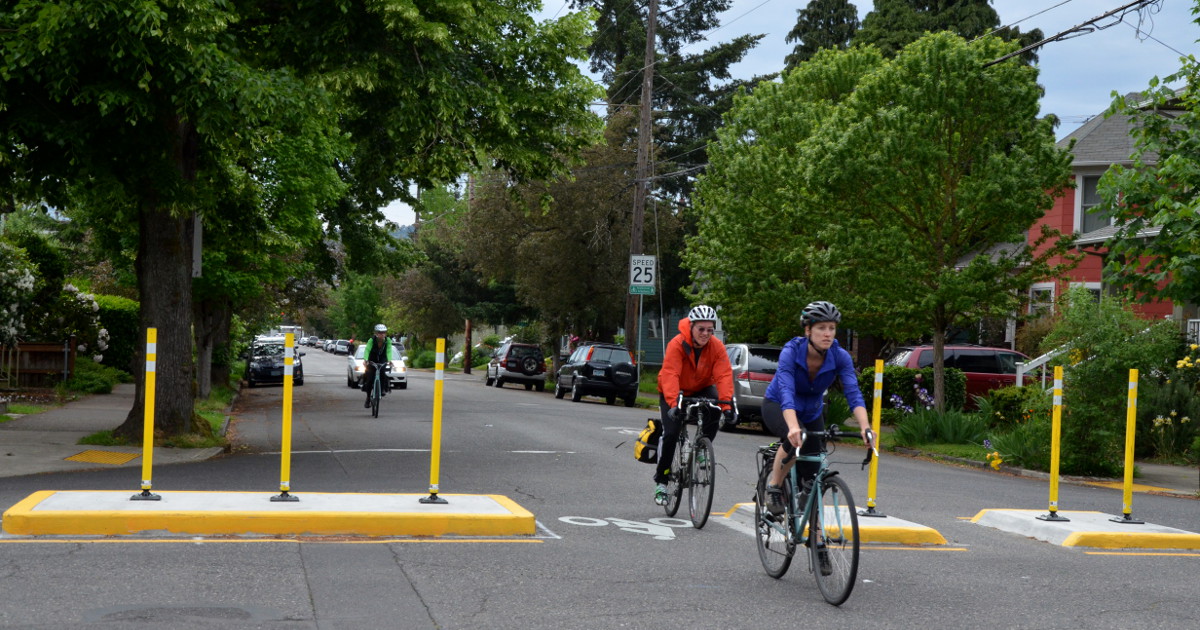
A traffic diverter in Portland. Photo: Jonathan Maus, Bike Portland
Some of the best places to bike in Chicago, or any other big city, are what I call "mellow routes," side streets that continue for many blocks without interruption, with stoplights or four-way stop signs to facilitate safe crossing of major streets. You can find these kinds of lower-stress streets on the Chicago Reader's Mellow Chicago Bike Map, for which I chose the routes.
Erie and Noble streets in West Town in West Town are textbook examples of what I'm talking about. Years ago when I lived near Chicago and Damen avenues in Ukrainian Village, taking Erie to Noble to Hubbard Street was one of my favorite low-stress ways to get downtown. I included these streets on the Mellow Map, and the Chicago Department of Transportation has striped bike lanes on this stretch of Noble.
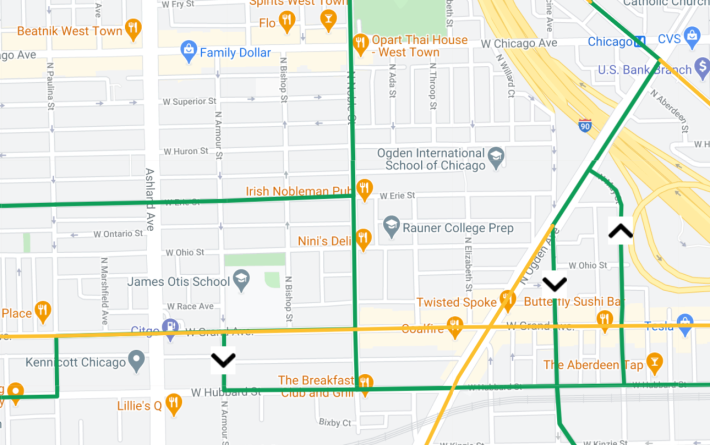
The only fly in the ointment with the mellow routes strategy is that some of these residential streets are also popular with drivers, who use them as "cut-through" routes in an effort to avoid traffic jams on main streets. That's why a secondary street like Wilson Avenue, which drivers use as an alternative to the nearby arterials, Montrose and Lawrence, is often jammed-up as well during normal rush hours. (As a result, I usually opt to ride on Leland or Sunnyside avenues, the tertiary streets adjacent to Wilson, instead, so it's great that there's currently a Slow Street, where through traffic is banned, basically running from the river to the lake on Leland -- more on Slow Streets in a bit.)
The problem of drivers using residential streets as cut-throughs has apparently come to a head on Erie and Noble. As reported today by Block Club's Hannah Alani, the owners of the Irish Nobleman Pub, which you can see labeled at the crossroads of the two streets in the map above, have launched a petition for speed humps on these roadways, in hopes that this would help prevent dangerous driving and street crime. The bumps would go on Erie between Noble and Racine Avenue, and Noble between Grand and Chicago avenues.
As Alani noted, these road segments run through aldermen Daniel LaSpata's (1st) and Walter Burnett's (27th) wards. Fortunately both of these City Council members are pretty hip to traffic safety issues. According to Chicago regulations, about two-thirds of the residents on each block would have to sign on to the plan to get the speed bumps approved.
Irish Nobleman owners Declan and Candace Morgan say that speeding, as well as shootings, have increased in recent years. “They’re just flying through, and they’re not even stopping at the stop signs,” Candace Morgan told Block Club. “I don’t know what the solution is. But something can help. If we can do anything to help, we should.” There were two shooting incidents near the intersection in September, although luckily no one was seriously injured. The Morgans argued that traffic calming would make it easier for security cameras to capture images of the vehicles of fleeing suspects.
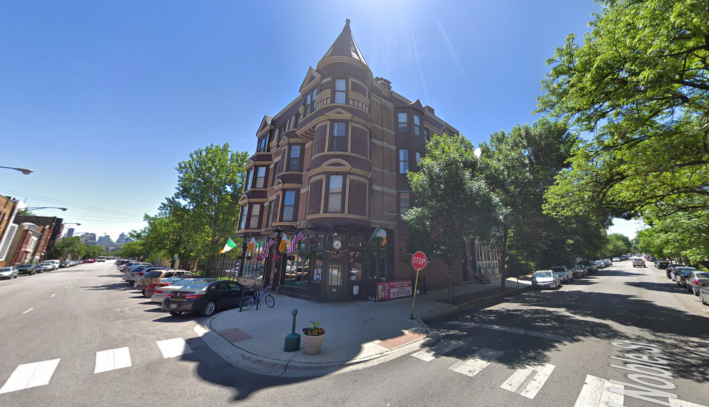
The couple told Alani that it's common for motorists to roll through the four-way stop in front of the bar, and navigation apps recommend using Noble as a rush-hour driving alternative to Ashland Avenue, an arterial two blocks west. Drivers whipping around the taverns corner, going over the sidewalk and striking planters, were such a problem that the Morgans installed U-shaped yellow barricades, but people still strike those. “They come flying up there, doing 60, 70 miles per hour,” Candace Morgan said.
Neighborhood residents who want to support the effort to get speed bumps on Erie and Morgan can sign the petition at the bar, or call 312-374-3487 for more info.
Speed humps would definitely be a step in the right direction for deterring reckless driving, and making it more difficult for people in cars to commit crimes in the area. But an even more effective strategy, which would also make Erie and Noble quieter, more pleasant streets, with better air quality, would be to make it physically impossible for drivers to use these roadways as cut-throughs, let alone zoom down them them at wildly dangerous speeds.
In more progressive, bike-friendly West Coast cities, "bike boulevards" treatments on side streets are common. These routes feature concrete "traffic diverters" that force drivers to turn off the streets at regular intervals, but have openings so that people biking can use them as through routes. This reduces the amount of car traffic on these streets, which makes also makes them safer, more pleasant places to walk and reside.
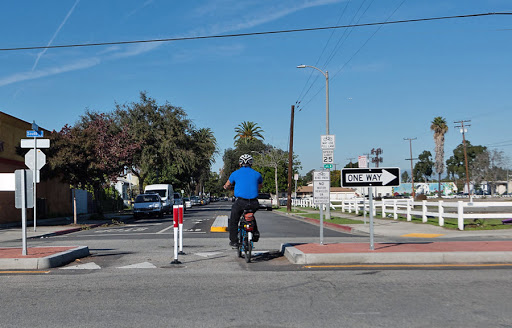
For whatever reason, bike boulevards and traffic diverters aren't really a thing in Chicago yet. (Some neighborhoods, such as Beverly do have cul-de-sac-ed streets where there happen to be gaps in the concrete curbs that make it possible to bike through them, but that probably wasn't the intention.) We do have "neighborhood greenways," which nowadays are essentially watered-down versions of bike boulevards. While they're intended as bike-priority streets, and they do feature traffic calming and pedestrian safety features like speed humps and sidewalk bump-outs, they don't feature traffic diverters, so drivers can still use them as cut-throughs.
In recent years, CDOT has proposed traffic diverters as part of neighborhood greenway projects on Berteau Street and Manor Avenue, going as far as to install temporary barricades on Manor to try out the idea. But motorists freaked out at having to modify their driving habits, so diverters were removed from the Berteau plan, and the Manor pilot was shut down early. Perhaps Chicago drivers are more set in their ways than their Seattle or Tucson counterparts. At any rate, the transportation department hasn't proposed traffic diverters in more recent neighborhood greenway plans, such as the one slated for construction on Leland between the river and Clark Street next year.
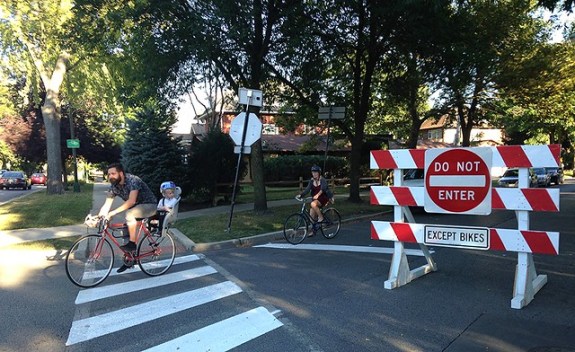
On the bright side, during the COVID-19 pandemic, CDOT has implemented a number of Slow Streets, side streets where through traffic is prohibited to make room for safe, socially-distanced walking and biking in the street. Barricades and traffic barrels are used to slow down drivers and discourage through traffic.
Granted, this strategy has had various degrees of success. It's worked great on Leland, but on some streets drivers where cut-though traffic is normally, more of a problem, disgruntled drivers have pushed the barricades and barrels aside and continued to illegally use the corridors as through routes.
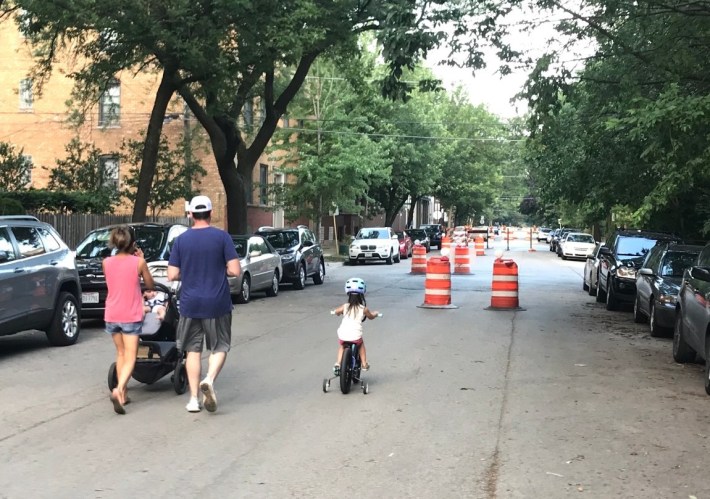
But implementing Slow Streets on Erie and Noble would still be a quick, cheap way to immediately address the speeding problem, and maybe even deter crime. The city should give that strategy a spin this fall, and consider piloting Chicago's first true traffic diverters on these streets next year.
After all, residential streets shouldn't be places for drivers to speed through on cross-town trips. They should be safe, peaceful places for people to walk, bike, play, and live.
In addition to editing Streetsblog Chicago, John writes about transportation and other topics for additional local publications. A Chicagoan since 1989, he enjoys exploring the city on foot, bike, bus, and 'L' train.
Stay in touch
Sign up for our free newsletter
More from Streetsblog Chicago
Which Metra corridor would become more bike-friendly and greener under a new plan? Ravenswood!
The avenue is slated to get a new Neighborhood Greenway bike route, and the Winnslie Parkway path and garden will be extended south.
They can drive 25: At committee meeting residents, panelist support lowering Chicago’s default speed limit
While there's no ordinance yet, the next steps are to draft one, take a committee vote and, if it passes, put it before the full City Council.
One agency to rule them all: Advocates are cautiously optimistic about proposed bill to combine the 4 Chicago area transit bureaus
The Active Transportation Alliance, Commuters Take Action, and Equiticity weigh in on the proposed legislation.



